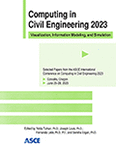A VR-Based Safety Training Program for General and Enabling Works in Construction Projects
Publication: Computing in Civil Engineering 2023
ABSTRACT
Past research has proved that the provision of effective safety training is a primary course of action that minimizes construction accidents. Similarly, the incorporation of VR technology in safety training has gained a wide momentum to overcome the limitations of traditional safety training. In fact, VR has proved to significantly contribute to the learning outcomes of trainees in construction training. However, existing safety VR-based training programs are incomprehensive with a limited number of hazards; thus, there still exists a gap when it comes to the transition from confined to thorough and all-inclusive VR-based training programs that conclusively address a specific topic. Against this backdrop, this research develops a full VR-based safety training program that addresses the hazards in general and enabling works of construction projects. This is done to verify the feasibility and viability of VR technology when implemented and used on a larger scale. The module consists of five chapters that are taught in 10 main consecutive VR scenarios addressing a wide range of relevant hazards. The results revealed that the development of the module is feasible and viable.
Get full access to this article
View all available purchase options and get full access to this chapter.
REFERENCES
Adams, E. (2021). Postmodernism and the Three Types of Immersion. Designersnotebook.com. Retrieved 30 September 2021, from http://designersnotebook.com/Columns/063_Postmodernism/063_postmodernism.htm.
Adami, P., Rodrigues, P. B., Woods, P. J., Becerik-Gerber, B., Soibelman, L., Copur-Gencturk, Y., and Lucas, G. (2021). Effectiveness of VR-based training on improving construction workers’ knowledge, skills, and safety behavior in robotic teleoperation. Advanced Engineering Informatics, 50, 101431. https://doi.org/10.1016/j.aei.2021.101431.
Ashbee, R. (2021). Curriculum: Theory, Culture and the Subject Specialism (1st ed.). Routledge.
Bhandari, S., Hallowell, M. R., and Correll, J. (2019). Making construction safety training interesting: A field-based quasi-experiment to test the relationship between emotional arousal and situational interest among adult learners. Safety Science, 117, 58–70. https://doi.org/10.1016/j.ssci.2019.03.028.
Chauhan, C. S., Bhavsar, A. N., and Pitroda, J. R. (2022). Challenges in High-Rise Building Projects for Parameters of Project Management: A Review. International Research Journal of Engineering and Technology (IRJET), 9(3), 1940–1947.
Dannewitz, B. (2022). Elements of VR design for learning. Motive.io. Retrieved September 21, 2022, from https://www.motive.io/blog/elements-of-great-vr-design/.
Gideon, L. (2016). Handbook of Survey Methodology for the Social Sciences. 1st ed. Springer.
Han, Y., Yang, J., Diao, Y., Jin, R., Guo, B., and Adamu, Z. (2022). Process and outcome-based evaluation between virtual reality-driven and traditional construction safety training. Advanced Engineering Informatics, 52, 101634. https://doi.org/10.1016/j.aei.2022.101634.
Dhalmahapatra, K., Maiti, J., and Krishna, O. B. (2021). Assessment of virtual reality based safety training simulator for electric overhead crane operations. Safety Science, 139, 105241. https://doi.org/10.1016/j.ssci.2021.105241.
Freitas, A. C., and Silva, S. A. (2017). Exploring ohs trainers’ role in the transfer of training. Safety Science, 91, 310–319. https://doi.org/10.1016/j.ssci.2016.08.007.
Eiris, R., John, B., Gheisari, M., Jain, E., Wehle, A., and Memarian, B. (2020a). Hazard-recognition training using omnidirectional cinemagraphs: Comparison between virtual reality and lecture-based techniques. Construction Research Congress 2020. https://doi.org/10.1061/9780784482865.118.
Eiris, R., Gheisari, M., and Esmaeili, B. (2020b). Desktop-based safety training using 360-degree panorama and Static Virtual Reality Techniques: A Comparative Experimental Study. Automation in Construction, 109, 102969. https://doi.org/10.1016/j.autcon.2019.102969.
Jeelani, I., Han, K., and Albert, A. (2020). Development of virtual reality and stereo-panoramic environments for construction safety training. Engineering, Construction and Architectural Management, 27(8), 1853–1876. https://doi.org/10.1108/ecam-07-2019-0391.
Joshi, S., Hamilton, M., Warren, R., Faucett, D., Tian, W., Wang, Y., and Ma, J. (2021). Implementing Virtual Reality Technology for safety training in the precast/ prestressed concrete industry. Applied Ergonomics, 90, 103286. https://doi.org/10.1016/j.apergo.2020.103286.
Li, W., Zhu, J., Dang, P., Wu, J., Zhang, J., Fu, L., and Zhu, Q. (2023). Immersive virtual reality as a tool to improve bridge teaching communication. Expert Systems with Applications, 217, 119502. https://doi.org/10.1016/j.eswa.2023.119502.
Lu, X., and Davis, S. (2016). How sounds influence user safety decisions in a virtual construction simulator. Safety Science, 86, 184–194. https://doi.org/10.1016/j.ssci.2016.02.018.
Mora-Serrano, J., Muñoz-La Rivera, F., and Valero, I. (2021). Factors for the Automation of the Creation of Virtual Reality Experiences to Raise Awareness of Occupational Hazards on Construction Sites. Electronics, 10(11), 1355. https://doi.org/10.3390/electronics10111355.
Nykänen, M., et al. (2020). Implementing and evaluating novel safety training methods for construction sector workers: Results of a randomized controlled trial. Journal of Safety Research, 75, 205–221. https://doi.org/10.1016/j.jsr.2020.09.015.
Rokooei, S., Shojaei, A., Alvanchi, A., Azad, R., and Didehvar, N. (2023). Virtual reality application for Construction Safety Training. Safety Science, 157, 105925. https://doi.org/10.1016/j.ssci.2022.105925.
Stachoň, Z., Kubicek, P., Málek, F., and Krejčí, M. (2018). 7th International Conference on Cartography and GIS. In The Role of Hue and Realism in Virtual Reality. Sozopol.
van Gisbergen, M., Kovacs, M., Campos, F., van der Heeft, M., and Vugts, V. (2019). What we don’t know. the effect of realism in virtual reality on experience and behaviour. Augmented Reality and Virtual Reality, 45–57. https://doi.org/10.1007/978-3-030-06246-04.
Zakaria, N., Saripan, M., Subarimaniam, N., and Ismail, A. (2020). Assessing Ethoshunt as a Gamification-Based Mobile App in Ethics Education: Pilot Mixed-Methods Study. JMIR Serious Games, 8(3), e18247. https://doi.org/10.2196/18247.
Information & Authors
Information
Published In
History
Published online: Jan 25, 2024
ASCE Technical Topics:
Authors
Metrics & Citations
Metrics
Citations
Download citation
If you have the appropriate software installed, you can download article citation data to the citation manager of your choice. Simply select your manager software from the list below and click Download.
